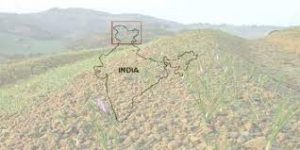What Are Karewas?

In the name of development, Kashmir’s highly fertile alluvial soil deposits called ‘karewas’ are being destroyed.
- Despite its agricultural and archaeological importance, karewas are now being excavated to be used in construction.
- In the Kashmiri dialect, the term Karewa means “elevated table land”.
- Firstly, this term was used by Godwin Austin in 1859 and later on by Lydekker in 1878 for unconsolidated to semi-consolidated sand clay conglomerate sequence.
- “Vudr” is the local name for Karewas in Kashmiri language.
- Karewas are the thick deposits of glacial clay and other materials embedded with moraines.
- These are unconsolidated lacustrine deposits. Lacustrine means “associated with lakes”.
- Kashmir valley resides between the Great Himalayas and the Pir Panjal ranges of the Kashmir Himalayas.
- In earlier times, when the upliftment of the Pir Panjal ranges happened, the flow of the river had stopped.
- As a result, the whole of Kashmir valley became a large lake.
- Slowly, the glacial deposits have accumulated here in this lake.
- Thus creating a large lacustrine plain.
- Later on, the water drained away and these unconsolidated deposits remained there.
- These unconsolidated gravel and mud deposits are known as Karewa formation.
- Karewa deposits have different soil and sediments such as sand, clay, silt, shale, mud, lignite and losses.
- Hence, these are very useful for agricultural and horticulture activities.
- Karewa formations are useful for the cultivation of Zafran is a local variety of Saffron in Kashmir valley.
- These are also important for the cultivation of almond, walnut, apple, and orchards.




